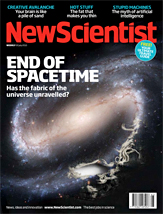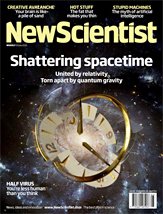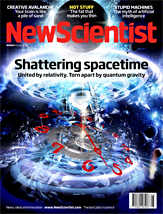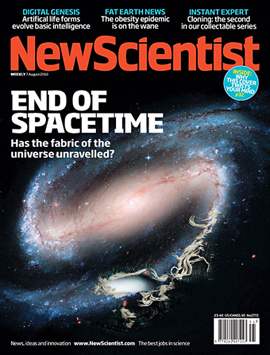 |
Scientific Enough?
Neuromarketing is an art too, but the science component is growing
An interview with Graham Lawton, Deputy Editor, New Scientist - 11th August 2010
It’s official, neuroscience tells you things you knew already.
...and things you don’t. And confirms some things that you thought were true but of which you’re now a lot more confident.
It’s beginning to sound like market research generally, is it not?
Why do I say official? Well, technically, the UK-based magazine New Scientist doesn’t have any official status, it’s a commercial operation and it’s not linked to the Royal Society or particularly recognised as a Bible by a majority of the scientific community worldwide or anything like that, but it is, notably, a publication full of scientific scepticism and not particularly renowned for its love of marketing or market research. So if it says, ‘I’m convinced this time there’s something in it’, we would tend to listen.
Deputy Editor Graham Lawton has emerged with this feeling of growing respect for the techniques of today’s neuromarketers from a recent project with prominent firm NeuroFocus.

|

|

|
| Test Cover 1 |
Test Cover 2 |
Test Cover 3 |
Lawton says there were three drivers for the current project: first, and perhaps most important, ‘though neuromarketing has been on the magazine’s radar for a while, there’s a feeling that it’s hitting the news more and more – it’s ‘out there’ – and therefore it’s something New Scientist should be aware of, tracking and investigating – an obligation to readers wanting to keep up to speed.
Secondly, there’s the specific purpose of the project in question, to run three possible covers for this week’s edition past a number of consumers, wired up for NeuroFocus’ testing, and gauge which was the most likely to sell on news stands, and why. This is something of genuine commercial value to the magazine, although the deal here was one of mutual promotion, with no money changing hands.
Thirdly, that mutual promotion – this is a ‘first’ for New Scientist, Lawton believes, and it’s already garnered a good few column inches and made good PR for both companies. And much of it gets past the usual ‘they’re messing with your head’ or ‘innit clever’ introductions to neuroscience, which can’t be a bad thing.
So, in a nutshell, New Scientist drafted three possible covers and ran them past 19 right-handed males identified as ‘occasional news stand buyers’. It’s not that the magazine has no left-handed or women readers – but with a sample of 19, one can’t afford to cut the data all ways or attempt to split to cover everyone. EEGs tracked the respondents’ reactions on seeing each cover, and then their brain activity as they were asked questions about it, while eye movements were also tracked and analysed.
Lawton says it would have been good to test more variables one by one – the method used left room for interpretation as covers differed in several factors, any of which might have caused the different reactions. Nevertheless, the results were informative. ‘Some things we have largely been doing right’, says Lawton. ‘For example, covers work well when the words and image tell the same story.’ In this case, the word ‘unravelled’ went with the fabric in one picture, helping to give it the edge over the two more explosive covers. ‘A strong, simple message is important, because you have about a tenth of a second to grab the attention.’

The Chosen Cover – Will it sell more?
In other cases, findings opened new lines of thought or helped to ‘articulate’ existing but vaguely defined beliefs, says Lawton. ‘For example, we had thought about the importance of emotional warmth, but that really does drive big scores. Whereas the clock face covers didn’t work - they've got broken glass... that’s something you shouldn’t have, along with volcanoes and spiders...’
Volcanoes and spiders? I’m sure I’ve seen them on the cover of all sorts of things, including this magazine. And don’t they hold an eerie fascination for some people? Well yes, but they’re not top of the list for New Scientist now – it seems they make people too uncomfortable. Whereas the colour red, for example, evokes strong positive emotions. How about red spiders? But let’s not get into that.
It will be interesting to see if news stand sales bear out the findings – but will it be easy, given that only the one cover was used – how will they know? ‘If we could have done a split cover run we would have done’ says Lawton, ‘but this was too expensive. As it is, we think we can get a good idea of the effectiveness of the cover because we have a good idea of how many we’d normally sell this time of year from stands.’
That doesn’t sound very scientific, but Lawton is aware of this: he recognises the whole project as an interesting exercise and hopefully one that’s breaking new ground - not something that’s going to be 100% robust. What’s more, he doesn’t see the whole discipline, neuromarketing, as a ‘science’ - it's got a big slice of art in it, and even the practitioners themselves would agree with that, he thinks. Will it ever be? I ask, and I can anticipate the answer: ‘More so...’ – but at least this opens up the whole topic of The Future, something on which the magazine is not shy of speculating.
The current grail of neuromarketing is a process that combines the two methodologies most commonly used to track the brain: EEG, which skates over the surface activity; and fMRI, which goes deeper – think Arnie in the travel agent’s in Total Recall, or various medical applications in current use, producing colourful and sliceable maps of the brain’s busy areas. Combining the two is a real challenge, Lawton explains – ‘they wire people up in very different ways’ and radiation from the one interferes with the measurements of the other – but it will be worth it. Although fMRI goes deep (‘Go deep, Haitian, and clean him out...’ – sorry but from here on in I am thinking Sci-Fi of one variety or another) – although it goes deep, there’s a ‘huge’ delay between the occurrence of various emotions deeper inside the brain and their manifestation on the outside. As much as 5 or 6 seconds in extreme cases, says Lawton – and it’s therefore very hard to tally them up with what’s being viewed, heard, said or done. If the two techniques can be overlaid one on the other with time series matching up, it begins to be possible to track the effects of these deeper events and draw lines between inner and outer brain: truly a new level of understanding.

Image from this week's New Scientist
New Scientist’s coverage of technological advance (and its ethical implications) is nothing if not broad, jumping between cosmology, gadgetry and GM crops with bewildering speed, and there are few better people to ask about the convergence of technology: what other fields will be married with neuroscience and what will their children be like? After a decent pause, Lawton says computing is the obvious answer – people are already growing neurons on chips and working on brain-computer interfaces. This begins to sound scary, and I’m thinking artificially enhanced intelligence and cyberpunk, but Lawton points out that there are wonderful applications already in production, such as retinal implants for the blind. ‘People instinctively find something sinister in this... it’s intrusive... ‘they’re looking inside my head’ - but to focus on neuromarketing itself, it’s really just an extension of what MR has done already in spades. It’s already a part of life – when you’re buying a car or watching a movie, chances are it’s the end result of a process that involved neuroscience somewhere along the line.’
If there’s a sinister side, it’s a familiar one. ‘It’s not inconceivable this has been used on political candidates’ says Lawton, ‘and obviously that does begin to throw up all sorts of issues.’ In a way, I’m not sure why that should be more sinister than neuromarketing’s contribution to the relentless march of consumerism, or indeed market research’s - but it does somehow seem so. Maybe, in order to find out why, I need to be wired up to an EEG or stuck in a scanner – but er, I reckon I could just give it some thought and get back to you on that one.
Which brings me back to the perennial question: where does neuromarketing fit in with traditional market research? I’m pleased to find that Graham Lawton, newly inspired as he is by the techniques but sceptical as I expect him to be, agrees with my general feeling: don’t expect it to replace ‘traditional’ MR any time soon. It will boom, but there’s plenty of niche for it to fill before it threatens anything else, and in the meantime, it’s ‘another tool in the market researcher’s toolbox.’
New Scientist is online at www.newscientist.com .

Nick Thomas
Comments on this article

Want to share your thoughts...?
NOTE: Please note that this board is moderated, and comments are published at the discretion of the site owner.
|